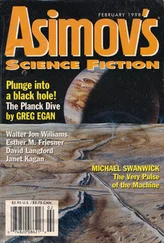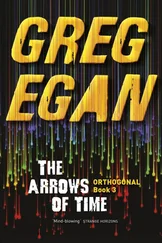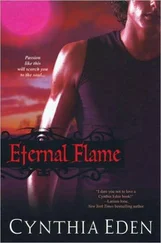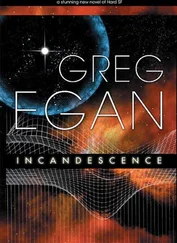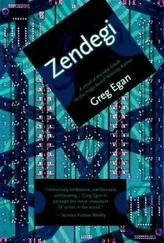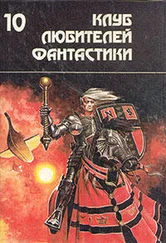Greg Egan - The Eternal Flame
Здесь есть возможность читать онлайн «Greg Egan - The Eternal Flame» весь текст электронной книги совершенно бесплатно (целиком полную версию без сокращений). В некоторых случаях можно слушать аудио, скачать через торрент в формате fb2 и присутствует краткое содержание. Жанр: Фантастика и фэнтези, на английском языке. Описание произведения, (предисловие) а так же отзывы посетителей доступны на портале библиотеки ЛибКат.
- Название:The Eternal Flame
- Автор:
- Жанр:
- Год:неизвестен
- ISBN:нет данных
- Рейтинг книги:4 / 5. Голосов: 1
-
Избранное:Добавить в избранное
- Отзывы:
-
Ваша оценка:
- 80
- 1
- 2
- 3
- 4
- 5
The Eternal Flame: краткое содержание, описание и аннотация
Предлагаем к чтению аннотацию, описание, краткое содержание или предисловие (зависит от того, что написал сам автор книги «The Eternal Flame»). Если вы не нашли необходимую информацию о книге — напишите в комментариях, мы постараемся отыскать её.
The Eternal Flame — читать онлайн бесплатно полную книгу (весь текст) целиком
Ниже представлен текст книги, разбитый по страницам. Система сохранения места последней прочитанной страницы, позволяет с удобством читать онлайн бесплатно книгу «The Eternal Flame», без необходимости каждый раз заново искать на чём Вы остановились. Поставьте закладку, и сможете в любой момент перейти на страницу, на которой закончили чтение.
Интервал:
Закладка:
6
Patrizia took the guide rope to the front of the room, then turned and addressed the class. “Suppose there are some luxagens in the mirrorstone that are bound so loosely that they can easily be freed from their energy valleys by a light wave. Suppose they get swept along by that wave, until they’re moving as fast as the light itself. If you compare the geometry of the light with the geometry of the luxagens’ motion, you can see that each of these luxagens ends up with an energy that’s proportional to the frequency of the light.”
Carla watched as the usually shy student sketched a diagram on her chest illustrating the relationship.
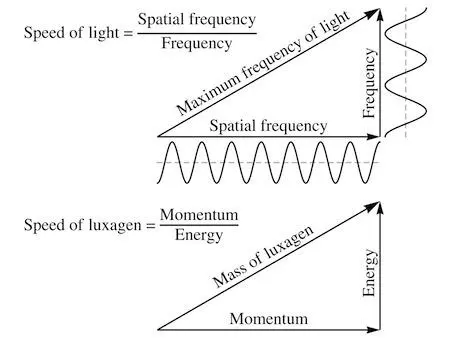
“To tarnish the mirrorstone at a given location,” Patrizia continued, “will require a certain amount of energy. Suppose that for light of the highest frequency, four luxagens can deliver that amount—so if a site in the mirrorstone is struck four times by these luxagens it will suffer the damage that we see as tarnishing. But as the frequency of the light falls, the energy per luxagen will fall too, so there’ll come a point where five luxagens would be needed to reach the same threshold. The tarnishing will still occur—but it will suddenly take much longer, and for a given exposure time it will be much fainter.”
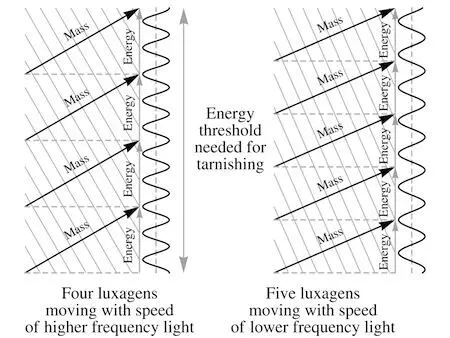
Patrizia drew four stacked energy vectors for luxagens at the transition point, then added a second stack that reached the same threshold with five particles. “Eventually the same thing will happen again: there’ll be a frequency below which even five luxagens won’t be sufficient. And the ratio of the two critical frequencies will be exactly five to four .”
Carla could only marvel at the young woman’s ingenuity. Yalda’s great discovery—on Mount Peerless, no less—was that the frequencies of light in time and in space formed two sides of a right triangle—with the ratio between these sides determined by the speed at which the light traveled, while the length of the hypotenuse remained fixed, regardless of whatever else was changed.
But the energy, momentum and mass of a solid object formed a right triangle too. This triangle’s hypotenuse was also fixed, by the object’s mass, while the speed of the object set the ratio between the other two sides.
Arrange for the speed to be the same in both cases—make a luxagen, a particle of matter, match speeds with a pulse of light—and the two triangles adopted the same shape, with corresponding sides locked into a fixed relationship. The energy of the particle became proportional to the frequency of the wave. And instead of the shifts in tarnishing being tied, inexplicably, to integer multiples of the light’s frequency, these particles in lock-step with the light would naturally carry energy in integer multiples.
Carla had set aside her planned lesson and invited her optics class to debate the tarnishing results. “This is your chance to argue for any wild idea you’re willing to defend,” she’d urged them, “even if you can’t make it perfect, even if there are gaps and flaws you can’t fix. There have been gaps and flaws in everything I’ve taught you, and mysteries people have struggled with since before the launch—but this time no one’s been there before you; Yalda, Nereo and Sabino can’t offer us their guesses. So this is your chance to go beyond everything you’ve learned: to see what’s missing in the old ideas, or to tear them down and start building something new.”
It had started slowly, with everyone tentative and wary—and the usual people needing prodding to get them to engage at all. But after half a bell of meandering, of questions and clarifications and increasingly passionate claims, three of her students had been brave enough to sketch their own novel explanations for the strange pattern in the tarnishing.
Romolo had suggested that the light striking the mirrorstone could be generating sound waves within the material, and some small nonlinearity in the equations for those waves was allowing energy to move between different harmonics, all the way up to the natural frequency of vibration of the luxagens. Palladio had proposed that light with the right frequency could give suitably timed kicks to the oscillating luxagens in such a manner that neighbors in the array were pushed together close enough to drag each other out of their energy valleys. But it was hard to see how either of these theories could predict a tiered pattern, rather than isolated bands of tarnish confined to a few special resonant frequencies.
Patrizia’s account certainly explained the tiers—and the analogy she’d used between energy and frequency was so simple and elegant that Carla was ashamed not to have thought of it herself. But for all its virtues, the theory as a whole didn’t quite hang together.
Carla broached the first problem as gently as she could. “You’re relying on some of the luxagens to get swept up by the light?”
“Yes,” Patrizia agreed. “Pushed along faster and faster, until they’re moving at the speed of the wave itself.”
“So how would that look, if we were moving alongside them? If we matched velocities with the luxagen, what would we see?”
“It would appear motionless to us,” Patrizia replied, puzzled. Wasn’t that obvious?
“And how would the light wave appear?”
“Motionless too. Everything’s moving with the same speed.”
“The light pulse is moving with the same speed,” Carla said, “the way you’ve envisioned this. But the history of a pulse is perpendicular in four-space to the wavefronts. So what are the wavefronts doing?”
“Oh.” Patrizia lowered her gaze and slumped away from the guide rope. “They’re going backward. And so the luxagen wouldn’t be moving with the pulse—it would be trapped in an energy valley between two wavefronts, moving backward at a completely different speed.”
Carla said, “Right. The motion of the pulse is not the motion of the wavefronts! It’s an easy mistake to make: I still get confused by the difference sometimes.”
She sketched the situation Patrizia had described. “For the luxagen to end up moving with a constant velocity, it has to be sitting in an energy valley. In fact, I’d only expect that to happen with a very high intensity light source, otherwise the valley wouldn’t be deep enough. But if it did happen, the luxagen would be motionless with respect to the wavefronts, not the pulse.”
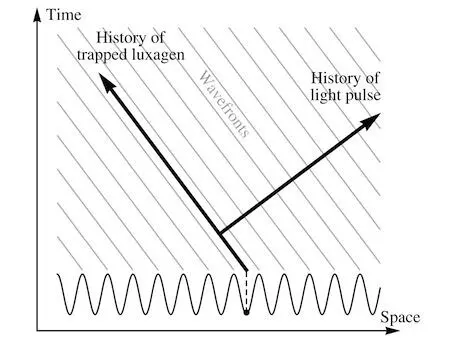
“I understand,” Patrizia said sadly. She began to move away.
Carla said, “Wait. There’s another problem here, and it’s worth discussing that as well.”
Patrizia was mortified now. “Isn’t the first flaw bad enough?”
“Bear with me for a moment,” Carla suggested. “Sometimes two errors actually cancel each other out.”
“Only sign errors!” Romolo interjected. Carla raised a hand to hush him, then turned back to Patrizia. “You had four or five mobile luxagens able to cause tarnishing when they reached a threshold in their total energy,” she said. “But if they’re going to strike another luxagen trapped in an energy valley, knocking that luxagen free will require a transfer of kinetic energy equal to the depth of the valley. Kinetic energy goes down as true energy increases, so your original idea, with the mobile luxagens matching the speed of the light pulse, wouldn’t have worked. But if the luxagens are moving with the wavefronts, not the light pulse, everything is reversed: the higher the frequency of the light, the slower the light pulse, but the faster the wavefronts. So luxagens trapped between wavefronts will be moving faster and carrying more kinetic energy when the frequency of the light is higher.”
Читать дальшеИнтервал:
Закладка:
Похожие книги на «The Eternal Flame»
Представляем Вашему вниманию похожие книги на «The Eternal Flame» списком для выбора. Мы отобрали схожую по названию и смыслу литературу в надежде предоставить читателям больше вариантов отыскать новые, интересные, ещё непрочитанные произведения.
Обсуждение, отзывы о книге «The Eternal Flame» и просто собственные мнения читателей. Оставьте ваши комментарии, напишите, что Вы думаете о произведении, его смысле или главных героях. Укажите что конкретно понравилось, а что нет, и почему Вы так считаете.

